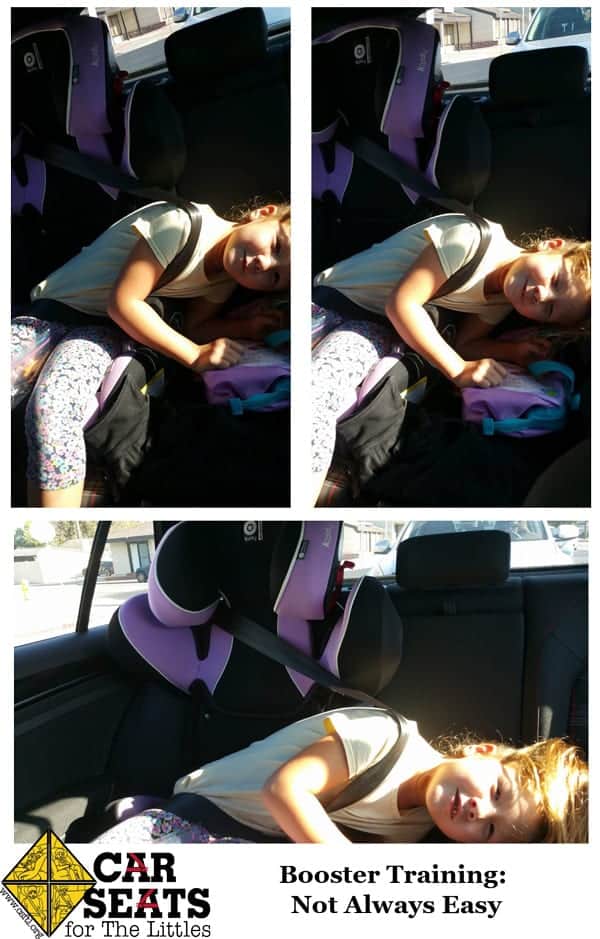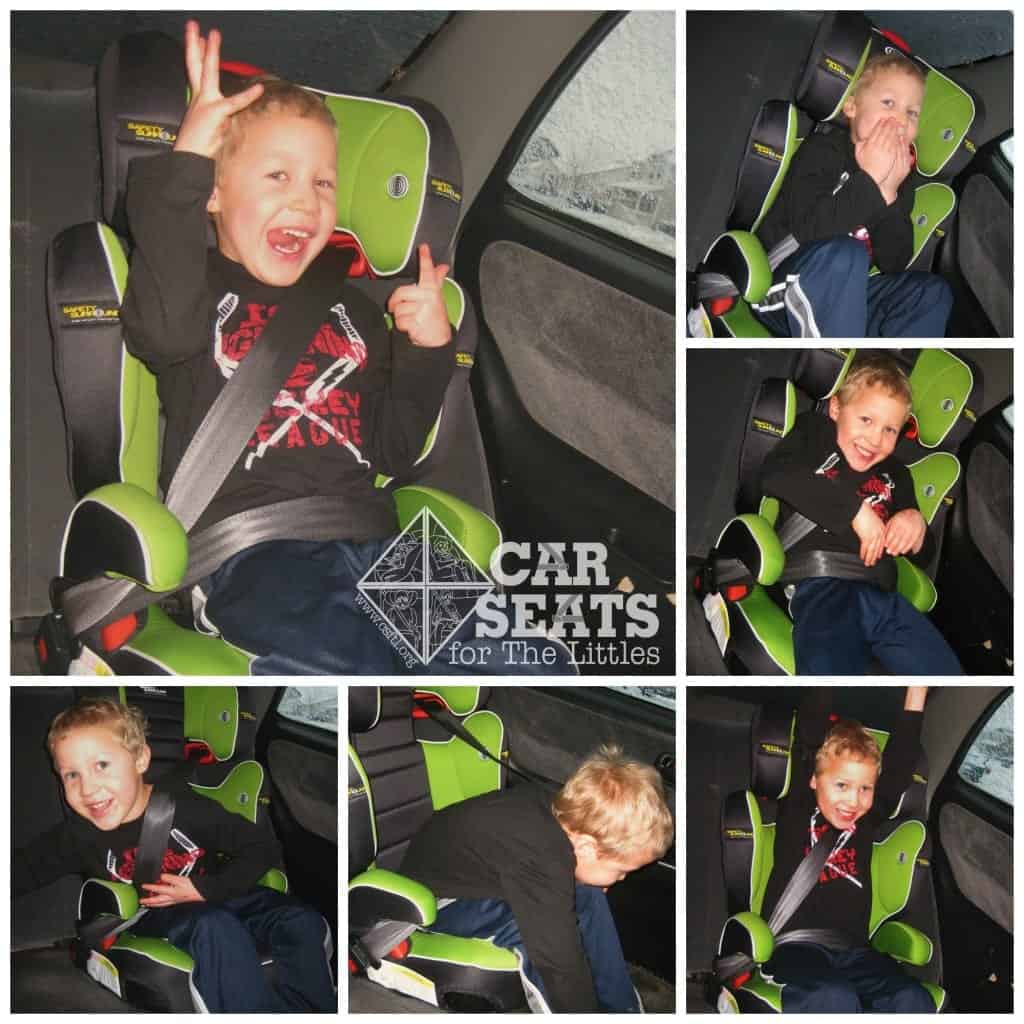On our Facebook group and on our Facebook page, we host a wide variety of questions but one that comes up a lot is: when should my child make the switch from a 5 point harness to a belt positioning booster?
While each child and each situation is different, our minimum recommended age for booster seats is 5 years old.
Wondering if your Little is ready to make this switch? There are a few things to consider in making this move.
What is a Booster Seat?
First, let’s define harnessed car seat versus booster seat:
A car seat with 5 point harness has – you guessed it! – 5 points of contact: shoulder, shoulder, hip, hip, crotch.
A belt positioning booster is a device designed to position the adult-sized seat belt in the correct locations over a child’s body. Boosters work by positioning the lap portion of the vehicle seat belt low on the child’s hips, contacting both the hips and thighs. Boosters also align the shoulder portion of the vehicle seat belt on the child’s shoulder, ideally placing the seat belt flat and snug across the collarbone.
As seat belts are designed to fit fully grown adults, children need a booster to correctly position the seat belt over their small body.
Differences Between a Harnessed Car Seat and a Booster Seat

Booster training: not always easy!
The major difference between these types of car seats is that a 5 point harness is a restraint. When a harnessed seat is properly tightened, it doesn’t allow the child freedom to move out of position.
Moving a child to a booster seat gives them freedom that they’ve never had before: freedom to lean sideways, slouch, bother their sister, pick up a toy off the floor, and so on and so forth. If a child is wiggling out of position at the time of a crash, that leaves them vulnerable to serious injury. That means the decision to move from harness to booster is rooted in the child’s maturity. The ability to sit correctly for the entire ride, 100% of the time, happens somewhere past age 5 for most kids, and not until 6 or 7 for many others.
This booster rider is 6 years old. He’s been practicing riding in a booster for short trips to begin introducing him to the responsibility (an endeavor many technicians refer to as “booster training”).
Let me tell you how this goes. For the first few minutes, maybe even a few weeks, things are going great. You think, gosh, my kid is so mature! He’s following all the rules, he’s sitting up straight, we’ve got this booster thing locked down!
And then, something shiny detracts his focus. The inner toddler comes out, and all the sudden you’ve got this happening in your backseat:
Moments like this scene are when you’ll know that your child just isn’t quite ready for a booster seat. We’ve heard legend of children who simply nod in agreement to The Rules of Booster Seats, then sit properly every time, but so far, we haven’t met those children.
Three Year Olds? NO!
The right time to switch to a booster seat is different for every child. However, we draw a hard line on young children riding in booster seats.
Despite the 3 year age minimum listed on some booster seats, there is not a 3 year old on the planet who is ready for the responsibility of sitting properly. Let their harnessed car seat do the work of keeping them in place.
Four Year Olds? ALSO NO!
Because this message is so important, we’ll say it again.
The right time to switch to a booster seat is different for every child. However, we draw a hard line on the youngest children riding in booster seats before they’ve outgrown their harnessed car seats. One recent study observed that 4-year-olds spent more than half of a simulated drive out of the proper booster position.
Despite the 4 year age minimum listed on some booster seats, we wouldn’t advocate for placing the burden of sitting properly in a booster seat on a 4 year old child. Let their harnessed car seat do the work of keeping them in place.
In our experience, the average child gains the maturity to sit properly in a booster seat somewhere between 5 and 7 years old. And even with that minimum age, we’ve met a lot of 8 year olds who still need reminders to sit properly, too.
Older Children
Every time we share this article, we invariably get comments from well-intentioned caregivers who let us know that their 7, 8, or 9 year old child is still harnessed. Once the child is old enough, weighs enough, is tall enough to fit properly in a booster seat, and mature enough to sit properly, there’s no advantage in using a harness over a booster seat.
What about Height and Weight?
Most booster seats have a lower weight threshold of 40 pounds, though some still have a 30 pound minimum weight. That’s the minimum. We advocate for waiting as long as possible to move a child to the next step in any child restraints. In this case, that means waiting until the child has outgrown their harnessed car seat before transitioning to a booster seat.
For our Canadian readers, all booster seats have at least a 40 pound minimum weight. There is some concern that a smaller child may be able to submarine (slide forward in the seat and slip out of the seat belt) beneath the lap belt in a crash, however, currently available studies do not have conclusive information for this phenomenon. We do know that a properly fitted seat belt does an excellent job of protecting a child in a crash, reducing the risk for serious injury by 45% for 4-8 year olds.1
The great news is that for most kids, there is no rush whatsoever to move into a booster seat. Not too long ago there were very few 5 point harnessed seats that could hold a child who weighs over 40 pounds. Today, there is a vast array of seats to choose from that can harness the average 5-6 year old – some of those options cost as little as $50. Check out our recommended seats list if you need help making a car seat selection!
Is a Harnessed Car Seat Safer than a Booster?
Once a child has outgrown their harnessed car seat, there isn’t any scientific information that gives us reason to believe that a harness is safer than a properly used booster seat. The key is the booster being properly used: where the child is of appropriate age and the belt is positioned properly.
NHTSA recommends utilizing a 5 point harness until the child outgrows it. There’s no rush to move to a booster right away, but if your child is nearing the weight or height maximum of their harnessed car seat and is behaviorally ready to ride in a booster, don’t feel that you are reducing their safety by moving to a booster.
High Back or Backless Booster?
We tend to prefer that children start out in a high back booster simply because the structure of the high back helps remind them to sit correctly. High back boosters also usually do a better job positioning the seat belt on smaller children than their backless counterparts. If your child likes to sleep in the car, a high back booster often makes it easier for a child to sleep comfortably without slumping out of position. When your child does move to a backless booster, be sure that they have a vehicle head restraint behind their head, at least up to the tips of their ears.
Five Step Test

Young adults who pass the Five Step Test can ride in the vehicle seat belt in the back seat of the vehicle.
Generally, kids will need a booster until they are 4’9″ tall, which tends to happen somewhere around age 11. To ride without a booster, a child needs to be able to pass the 5 Step Test:
- Sits all the way back against the vehicle seat.
- Knees bent at the edge of the vehicle seat and feet on the floor.
- Shoulder belt fits evenly across the collarbone and sits flush with the torso.
- Lap belt is low on the hips, touching the tops of the thighs.
- Can stay comfortably seated this way the entire ride.
The Bottom Line
Before moving to a booster seat, your child should:
- Be at least 5 years old.
- Meet the weight and height minimums for the booster seat you’re considering.
- Be responsible enough to sit properly 100% of the time, even while asleep.
- Have a safe belt fit. Here’s how they should look:
- Arbogast KB, Jermakian JS, Kallan MJ, Durbin DR. Effectiveness of belt positioning booster seats: an updated assessment. Pediatrics 2009; 124; 1281-6.
Originally written by Emma Douglas. Edits maintained by CSFTL.








